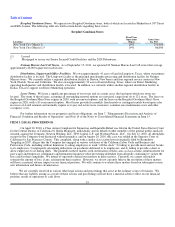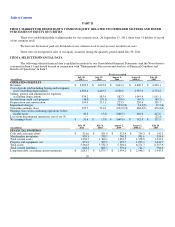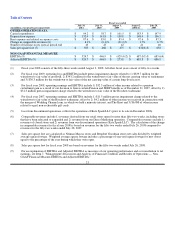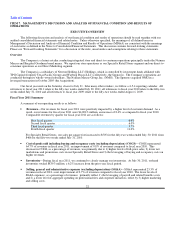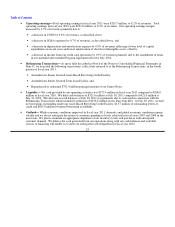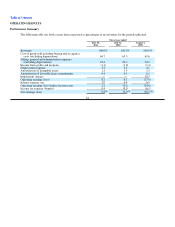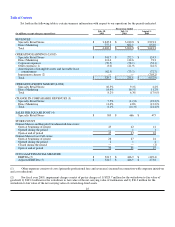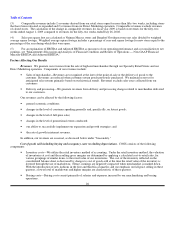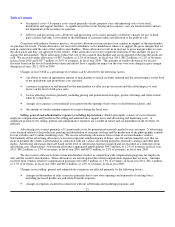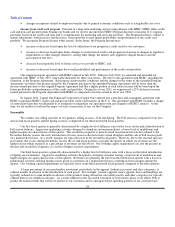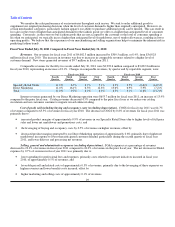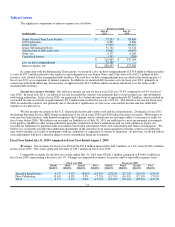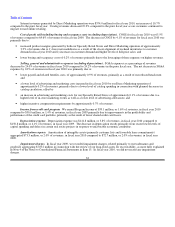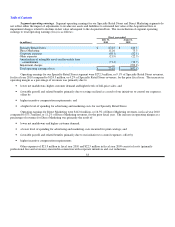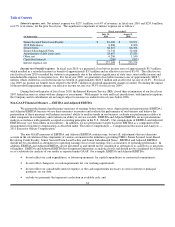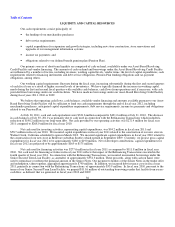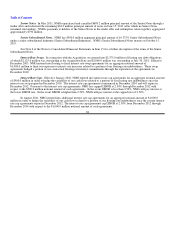Neiman Marcus 2010 Annual Report Download - page 32
Download and view the complete annual report
Please find page 32 of the 2010 Neiman Marcus annual report below. You can navigate through the pages in the report by either clicking on the pages listed below, or by using the keyword search tool below to find specific information within the annual report.
Table of Contents
• changes in expenses related to employee benefits due to general economic conditions such as rising health care costs.
Income from credit card program. Pursuant to a long-term marketing and servicing alliance with HSBC, HSBC offers credit
card and non-card payment plans bearing our brands and we receive income from HSBC (Program Income) consisting of 1) ongoing
payments based on net credit card sales and 2) compensation for marketing and servicing activities. The Program Income is subject to
annual adjustments, both increases and decreases, based upon the overall annual profitability and performance of the credit card
portfolio. We recognize Program Income when earned. In the future, the Program Income may:
• increase or decrease based upon the level of utilization of our proprietary credit cards by our customers;
• increase or decrease based upon future changes to our historical credit card program in response to changes in regulatory
requirements or other changes related to, among other things, the interest rates applied to unpaid balances and the
assessment of late fees;
• decrease based upon the level of future services we provide to HSBC; and
• increase or decrease based upon the overall profitability and performance of the credit card portfolio.
Our original program agreement with HSBC expired in July 2010. Effective July 2010, we amended and extended our
agreement with HSBC to July 2015 (renewable thereafter for three-year terms). We refer to the agreement with HSBC, including the
extension, as the Program Agreement. Based upon current market conditions and the changes in the terms of the extended Program
Agreement, we believe the income earned by the Company pursuant to the amended Program Agreement will be lower than the
income earned pursuant to the original Program Agreement and that a higher portion of such future income will be based upon the
future profitability and performance of the credit card portfolio. During fiscal year 2011, we experienced a 22% decline in income
earned pursuant to the Program Agreement with HSBC as compared to income earned in fiscal year 2010.
In August 2011, Capital One Financial Corporation (Capital One) entered into a purchase and assumption agreement with
HSBC to purchase HSBC's credit card and private label credit card business in the U.S. Our agreement with HSBC includes a change
of control provision that would permit us to terminate or renegotiate our agreement with any assignee of HSBC's interest. At this
time, we are unable to evaluate the impact of such a transaction, if any, on the Company.
Seasonality
We conduct our selling activities in two primary selling seasons—Fall and Spring. The Fall season is comprised of our first
and second fiscal quarters and the Spring season is comprised of our third and fourth fiscal quarters.
Our first fiscal quarter is generally characterized by a higher level of full-price sales with a focus on the initial introduction of
Fall season fashions. Aggressive marketing activities designed to stimulate customer purchases, a lower level of markdowns and
higher margins are characteristic of this quarter. The second fiscal quarter is more focused on promotional activities related to the
December holiday season, the early introduction of resort season collections from certain designers and the sale of Fall season goods
on a marked down basis. As a result, margins are typically lower in the second fiscal quarter. However, due to the seasonal increase
in revenues that occurs during the holiday season, the second fiscal quarter is typically the quarter in which our revenues are the
highest and in which expenses as a percentage of revenues are the lowest. Our working capital requirements are also the greatest in
the first and second fiscal quarters as a result of higher seasonal requirements.
Our third fiscal quarter is generally characterized by a higher level of full-price sales with a focus on the initial introduction
of Spring season fashions. Aggressive marketing activities designed to stimulate customer buying, a lower level of markdowns and
higher margins are again characteristic of this quarter. Revenues are generally the lowest in the fourth fiscal quarter with a focus on
promotional activities offering Spring season goods to customers on a marked down basis, resulting in lower margins during the
quarter. Our working capital requirements are typically lower in the third and fourth fiscal quarters compared to the other quarters.
A large percentage of our merchandise assortment, particularly in the apparel, fashion accessories and shoe categories, is
ordered months in advance of the introduction of such goods. For example, women's apparel, men's apparel, shoes and handbags are
typically ordered six to nine months in advance of the products being offered for sale while jewelry and other categories are typically
ordered three to six months in advance. As a result, inherent in the successful execution of our business plans is our ability both to
predict the fashion trends that will be of interest to our customers and to anticipate future spending patterns of our customer base.
28



